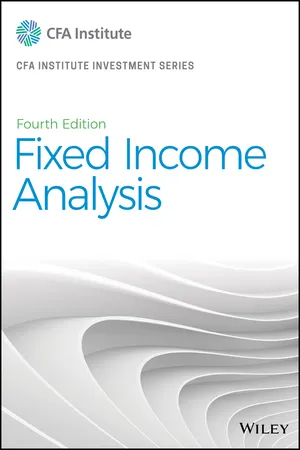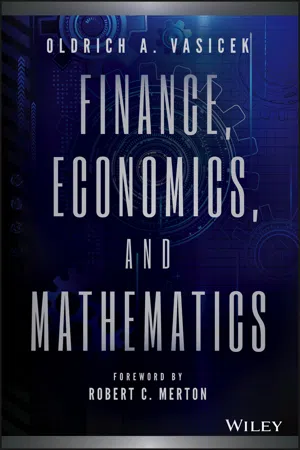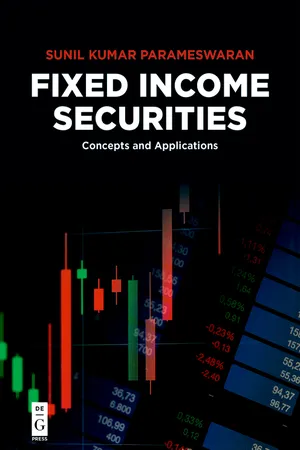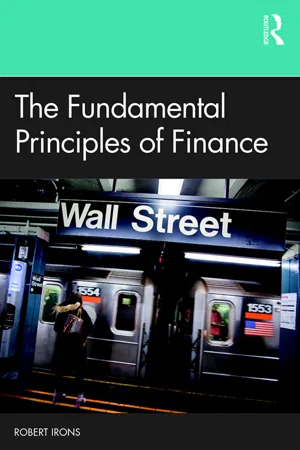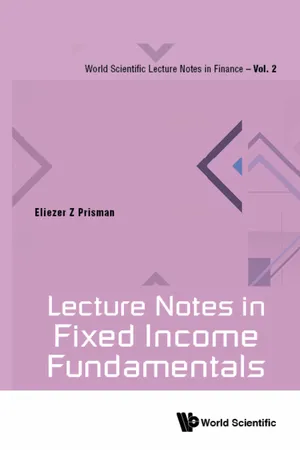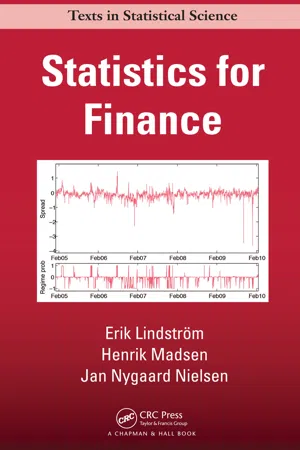Economics
Term Structure Theories
Term structure theories in economics refer to the various models and frameworks used to explain the relationship between interest rates and the maturity of fixed-income securities. These theories aim to understand the yield curve and the factors influencing its shape, such as expectations about future interest rates, risk premiums, and market segmentation. By analyzing the term structure of interest rates, economists can gain insights into market expectations and economic conditions.
Written by Perlego with AI-assistance
Related key terms
Related key terms
1 of 4
Related key terms
1 of 3
11 Key excerpts on "Term Structure Theories"
- eBook - ePub
The Creators of Inside Money
A New Monetary Theory
- D. Gareth Thomas(Author)
- 2018(Publication Date)
- Palgrave Macmillan(Publisher)
The term structure of interest rates, however, recognises a common link between them all in the form of expectations of the future, whether long or short, which determines the holding of various financial assets of maturity as well as influencing the determination of aggregate demand and supply within the real economy. The term structure, therefore, is important for Central Bank ’s policymakers. If these monetary instruments affect short-term rates of interest in the first instance, which leads to the determination of long-term rates of interest, which drives capital and consumption expenditure, then analysing the term structure is crucial for understanding the transmission mechanism of monetary policy (Fender 2012). 1 Nevertheless, it is also relevant for many households in terms of the portfolio choice of assets. Suppose a family requires expenditure on private school fees in ten years’ time and decides to save now. There are a number of options. They could save by investing into a ten-year bond. Alternatively, they could purchase a short-term bill and then take the earnings into another bond each time it matures, until the ten years are up. Clearly, the important components determining the choice will be the expected return (or cost) and the risk involved, embodied in the term structure. Therefore, the analysis must consider the various theoretical models put forward in the literature to explain the relationship between interest rates on bonds (or bills) of differing maturity, although the hypothesis can applied to other assets as diverse as housing and the mortgage rate. The foremost theory of the term structure of interest rates is the so-called expectations hypothesis, which focuses on the rôle of expectations of future short-term interest rates in the determination of prices and yields on longer-term bills (or bonds). There a number of ways in which the theory in the literature differs in terms of the length of the bills (or bonds) included in the analysis - eBook - ePub
- Barbara S. Petitt(Author)
- 2019(Publication Date)
- Wiley(Publisher)
Solution to 5: A is correct. Although the local expectations theory predicts that the short-run return for all bonds will be equal to the risk-free rate, most of the evidence refutes that claim. Returns from long-dated bonds are generally higher than those from short-dated bonds, even over relatively short investment horizons. This market evidence is consistent with the risk–expected return trade-off that is central to finance and the uncertainty surrounding future spot rates.5. Modern Term Structure Models
Modern term structure models provide quantitatively precise descriptions of how interest rates evolve. A model provides a sometimes simplified description of a real-world phenomenon on the basis of a set of assumptions; models are often used to solve particular problems. These assumptions cannot be completely accurate in depicting the real world, but instead, the assumptions are made to explain real-world phenomena sufficiently well to solve the problem at hand.Interest rate models attempt to capture the statistical properties of interest rate movements. The detailed description of these models depends on mathematical and statistical knowledge well outside the scope of the investment generalist’s technical preparation. Yet, these models are very important in the valuation of complex fixed-income instruments and bond derivatives. Thus, we provide a broad overview of these models in this chapter. Equations for the models and worked examples are given for readers who are interested.5.1. Equilibrium Term Structure Models
Equilibrium term structure models are models that seek to describe the dynamics of the term structure using fundamental economic variables that are assumed to affect interest rates. In the modeling process, restrictions are imposed that allow for the derivation of equilibrium prices for bonds and interest rate options. These models require the specification of a drift term (explained later) and the assumption of a functional form for interest rate volatility. The best-known equilibrium models are theEquilibrium term structure models share several characteristics:Cox–Ingersoll–Ross model10 and theVasicek model,11 which are discussed in the next two sections.- They are one-factor or multifactor models. One-factor models assume that a single observable factor (sometimes called a state variable) drives all yield curve movements. Both the Vasicek and CIR models assume a single factor, the short-term interest rate, r
- eBook - ePub
- Oldrich A. Vasicek(Author)
- 2015(Publication Date)
- Wiley(Publisher)
Term structure of interest rates provides a characterization of interest rates as a function of maturity. It facilitates the analysis of rates and yields such as discussed in Dobson, Sutch, and Vanderford [1976], and provides the basis for investigation of portfolio returns as for example in Fisher and Weil [1971]. Term structure can be used in pricing of fixed-income securities (cf., for instance, Houglet [1980]), and for valuation of futures contracts and contingent claims, as in Brennan and Schwartz [1977]. It finds applications in analysis of the effect of taxation on bond yields (cf. McCulloch [1975a] and Schaefer 1981), estimation of liquidity premia (cf. McCulloch [1975b]), and assessment of the accuracy of market-implicit forecasts (Fama [1976]). Because of its numerous uses, estimation of the term structure has received considerable attention from researchers and practitioners alike.A number of theoretical equilibrium models has been proposed in the recent past to describe the term structure of interest rates, such as Vasicek [1977] (Chapter 6 of this volume), Brennan and Schwartz [1979], Langetieg [1980], and Cox, Ingersoll, and Ross [1981]. These models postulate alternative assumptions about the nature of the stochastic process driving interest rates, and deduct a characterization of the term structure implied by these assumptions in an efficiently operating market. The resulting spot rate curves have a specific functional form dependent only on a few parameters.Unfortunately, the spot rate curves derived by these models (at least in the instances when it was possible to obtain explicit formulas) do not conform well to the observed data on bond yields and prices. Typically, actual yield curves exhibit more varied shapes than those justified by the equilibrium models. It is undoubtedly a question of time until a sufficiently rich theoretical model is proposed that provides a good fit to the data. For the time being, however, empirical fitting of the term structure is very much an unrelated task to investigations of equilibrium bond markets. - eBook - ePub
- Friedrich A. Lutz(Author)
- 2017(Publication Date)
- Routledge(Publisher)
Part FourThe Term Structure of Interest RatesOur presentation of the various theories of the term structure of interest rates will be organized not by author but, rather, according to the type of the theory. We begin with the best known one according to which the long-term interest rate is an average of the expected short-term rates. By bringing in the required qualifications, we can subsume under this theory a very large part of the contributions to the problem of the term structure of interest rates. In Chapter 18 we shall deal with two further attempts to construct theories of the rate structure, and in Chapter 19 we shall consider the question of the “basic rate”, – i.e., which of the many interest rates the theory of interest should primarily determine so as to give the whole structure a peg. We shall omit a discussion of the valuable attempts to verify some of the theories, even though we have followed them with much interest and were pleased to see that one author believes he is able to refute the most widely accepted theory by appealing to the empirical evidence1 , while another thinks that the facts support it2 and a third claims that the same empirical material that was used by the first supports rather than refutes this theory.31 J. M. Culbertson, ‘The Term Structure of Interest Rates’, Quarterly Journal of Economics, 71 (1957) 485-517.2 D. Meiselman, The Term Structure of Interest Rates (Englewood Cliffs, N. J., 1962).3 J. B. Michaelsen, The Term Structure of Interest Rates: Comment’, Quarterly Journal of Economics, 77 (1963) 166-174.Passage contains an image
CHAPTER 17The Expectation Theory of the Term Structure of Interest Rates
Already Irving Fisher, as we saw, viewed the long-term rate as an average of the short-term rates which are expected to prevail during the period for which a long-term loan is granted. He was the first to develop what we here call the “expectation theory” of the term structure of interest rates.4 In expounding this theory, let us first assume perfect foresight and neglect the costs which arise if an investor shifts from short maturities to longer ones or vice versa. In this case competition will equalize the yield on all investments undertaken for equal periods, regardless of what form they take – i.e., whether we are dealing with a short-term investment repeated several times, or with a single long-term investment, or with several short-term investments succeeded by a longer-term one, and so on. If the condition of equal yields on all possible configurations of investments over the same time span is not fulfilled, profitable arbitrage operations can and will be carried out with the result that yields will be equalized. The sum into which a dollar grows if invested for n years at the long-term rateRnmust then be equal to the sum into which it would grow if it were invested several times in succession at the short-term rates r 1 , r 2 ... r n - eBook - ePub
- Frank J. Fabozzi, Frank J. Fabozzi(Authors)
- 2012(Publication Date)
- Wiley(Publisher)
With each of these theories, one can assess their efficacy only in the context of the general economy. Specifically, we assume that the economy is one in which investors have an inclination to consume, as well as to invest (in fact, even in a diverse set of risky investments). With a specification of utility of consumption and wealth, as well as a formal expression for risk aversion, the risk-based Term Structure Theories can be viewed in the context of markets. Given that risk-based Term Structure Theories can be viewed in the context of a defined market, the following conclusions can be made.Term premiums are monotonic in maturity (or term). Interest-rate risk is inherently intertemporal. That is, it is a multiperiod phenomenon, in which an unexpected interest-rate change at any period affects all future returns and risk compounds over time. The traditional notion of preferred habitat seems difficult to reconcile with real markets. As it turns out, the traditional notion omits the importance of risk aversion. As we incorporate a varying need to hedge against interest-rate changes, the theory converges to a more acceptable view of markets. The generalization of these economic analyses has led to what has been called an eclectic theory of the term structure that recognizes and accommodates the many factors that play a role in shaping the term structure. Expectations of future events, risk preferences, and the characteristics of a variety of investment alternatives are all important, as are the individual preferences (habitats) of market participants about the timing of their consumption. It is this eclectic theory that one needs to embrace in the development of the dynamic term structure.CONTINUOUS-TIME MODELS OF THE TERM STRUCTURENow we discuss how the earlier concepts of discount function, spot rate, spot yield, and forward rate have their analogies in the continuous-time domain. It will be seen that while the mathematics are slightly more complex, the roles that each of these quantities play in the term structure of interest rates remain unchanged.In summary, the priced-based representation of the term structure, or the discount function, facilitates both the mathematical formulation of the problem and its subsequent solution. Once the term structure equation is solved explicitly in terms of price, the price/yield equation (in continuous time) is used to convert the term structure to its equivalent representation in terms of yield. - eBook - ePub
- (Author)
- 2021(Publication Date)
- Wiley(Publisher)
Section 1 explains how spot (or current) rates and forward rates, which are set today for a period starting in the future, are related, as well as how their relationship influences yield curve shape. Section 2 builds upon this foundation to show how forward rates impact the yield-to-maturity and expected bond returns. Section 3 explains how these concepts are put into practice by active fixed-income portfolio managers.The swap curve is the term structure of interest rates derived from a periodic exchange of payments based on fixed rates versus short-term market reference rates rather than default-risk-free government bonds. Sections 4 and 5 describe the swap curve and its relationship to government yields, known as the swap spread, and explains their use in valuation.Section 6 describes traditional theories of the term structure of interest rates. These theories outline several qualitative perspectives on economic forces that may affect the shape of the term structure.Section 7 describes yield curve factor models. The focus is a popular three-factor term structure model in which the yield curve changes are described in terms of three independent movements: level, steepness, and curvature. These factors can be extracted from the variance−covariance matrix of historical interest rate movements.Section 8 builds on the factor model and describes how to manage the risk of changing rates over different maturities. Section 9 concludes with a discussion of key variables known to influence interest rates, the development of interest rate views based on forecasts of those variables, and common trades tailored to capitalize on an interest rate view. A summary of key points concludes the reading.1.1 . Spot Rates and Forward Rates
We first explain the relationships among spot rates, forward rates, yield-to-maturity, expected and realized returns on bonds, and the shape of the yield curve. We then discuss the assumptions made about forward rates in active bond portfolio management. - eBook - ePub
Fixed Income Securities
Concepts and Applications
- Sunil Kumar Parameswaran(Author)
- 2019(Publication Date)
- De Gruyter(Publisher)
One policy implication of this hypothesis is that if the submarkets are isolated, the central bank can alter the shape of the curve by influencing the supply and demand dynamics in one or more market segments. For instance, if the objective is to have an upward sloping yield curve, the central bank can flood the market with long-term bonds and acquire short-term bonds. This causes long-term bond prices to fall or, equivalently, long-term yields to rise. At the same time the induced demand for short-term bonds, pushes up prices in this market segment, causing short-term yields to fall. The net consequence is an upward sloping yield curve.While the expectations hypothesis argues that securities are perfect substitutes for each other, this theory goes to the other extreme, by arguing that investors and issuers are so risk averse that they buy and sell bonds only for maturities matching their desired time horizons.The Preferred Habitat Theory
The preferred habitat theory is a slightly modified version of the segmentation hypothesis. This suggests that different market participants have an interest in specified areas of the yield curve but can be persuaded to hold bonds from other parts of the maturity spectrum if they are provided with sufficient incentives. Hence, banks, which typically operate at the short-end of the spectrum, may at times hold long-dated bonds when the price of these bonds falls to a certain level, thereby ensuring that the returns from holding such bonds is commensurate with the attendant risk. Similar considerations may persuade long-term investors to hold short-term debt. So the incentive for an investor to shift out of his preferred habitat is the inducement offered by way of a higher rate of interest.Features of the Debt Market and Theories of the Term Structure
In practice we find that the yield curve is generally upward sloping, and yields tend to taper off at longer maturities.8 - eBook - ePub
- Robert Irons(Author)
- 2019(Publication Date)
- Routledge(Publisher)
4 The Term Structure of Interest RatesInterest is the cost of debt. The interest rate (or yield) on a loan or a bond is a return to the lender and a cost to the borrower. Interest is charged when taking out a loan from a bank, when using a credit card and when financing a major purchase like a car. Interest is also paid by the government when issuing Treasury bonds and by firms when they use bank loans to fund operations, or when they issue bonds. In this chapter, we will discuss how interest rates are determined, the relationship between short-term and long-term interest rates and the theories that have been offered to explain that relationship.Market interest rates are influenced by a number of different things, and the resulting changes are not always easy to understand or appreciate. For example, it is possible for inflation to be negative—for prices to fall. This is known as deflation, and at first glance it may seem to be a good thing; falling prices are good for consumers, aren’t they? Yes, but they are bad for producers, and they can result in layoffs and therefore increased unemployment, which in turn can slow down the economy. In particularly bad economies, it is possible that risk-averse investors would be willing to pay for a financial institution to hold their cash, meaning that they would be willing to earn a negative interest rate. Some bonds issued by various entities in 2014 and 2015 were seen to temporarily earn negative interest rates, including some bonds issued by the US Treasury. In this chapter, we will discuss the theory of how interest rates are determined in the market, and how they can be used to compare different debt instruments.When professionals discuss bond yields, they speak in terms of basis points. One basis point is one one-hundredth of a percentage point (0.01%, or 0.0001 in decimal format). One hundred basis points equal one percentage point.The previous chapter examined the direct relationship between risk and return. Since interest is a return to the lender, it follows that there is a direct relationship between the perceived riskiness of the borrower and the rate of interest paid by the borrower. This relationship will be made clear in the discussion regarding the components of the nominal interest rate. - eBook - ePub
- Eliezer Z Prisman(Author)
- 2017(Publication Date)
- WSPC(Publisher)
Chapter 3
The Term Structure, its Estimation, and Smoothing
In the last chapter we investigated the meaning of the discount factors and their relation to the NA condition, and valuing future cash flows utilizing the present value concept. Some financial instruments, that also fall into the class of derivative securities, are valued based on risk-free discount factors. The valuation concept of these instruments is induced by the no-arbitrage condition. These securities are valued either by replication or by applying to their cash flow the discount factors.The risk-free discount factors are implicit in bond prices, as we saw in Chapter 2 . They are consequences of the no-arbitrage condition. However before we dwell on the valuation issue, we introduce the reader to some estimation matters, terminology such as yield, yield curve, spot curve, and zero-coupon curve, and their interrelation.3.1 The Term Structure of Interest Rates
The discount factors (ds) reflect the discounting due to the time value of money. Thus, they have implicit in them the interest rate that prevails in the market. For example, if d1 = 0.9 it means that in this market a dollar at time one is worth 0.9 of a dollar today. The difference in value between a dollar today and a dollar received in the future results from the opportunity cost of investing that dollar at the risk-free rate of interest. A dollar today can be invested in a risk-free asset from time zero to time one and will earn a rate of interest which we denote by r1 . Hence a dollar today will be equal to 1 + r1 dollars at time one. Consequently, if invested at the risk-free rate from time zero to time one, will grow to be one dollar. It thus follows thatand we can solve for r1 in terms of d1 .> solve(d1=1/(1+r1),r1);The rate r1 is called the spot rate spanning the time interval zero to one. It is the rate applied to loans which commence now (at time zero) and which mature at some time in the future — time one in this example. In the same manner we can calculate the rate r2 - eBook - ePub
- Erik Lindström, Henrik Madsen, Jan Nygaard Nielsen(Authors)
- 2018(Publication Date)
- Chapman and Hall/CRC(Publisher)
Here the statistical term estimation of the term structure will be used throughout. In Section 14.11.3, the Extended Kalman filtering technique from Chapter 14 will be used, where the spot interest rate model describes the underlying process and the solution of the bond pricing equation is the measurement equation. Thus the method enables us to estimate both parameters and implied interest rates directly from observed bond prices. 11.6.1 Polynomial methods In practice it is fairly common to assume that the yield curve may be approximated by a polynomial in T of order s, i.e., Y (T) = α − 1 + α 1 T + α 2 T 2 + … + α s T s. (11.152) This is a reasonably general formulation. A number of estimation methods exist and have been implemented in statistical packages, which we shall not discuss here. A program package called RIO, which is based on cubic splines, has been developed at the Aarhus School of Business. This package is also used today in a number of financial institutions, because it allows the modeller to split the term structure into a number of segments. The package can also calculate other types of information. 11.6.2 Decay functions Decay functions are very useful for term structure estimation if the term structure should converge to a constant interest rate for T → ∞. The simplest possible decay function is Y (T) = α 0 + α 1 exp (− α 2 T). (11.153) In the next section, we discuss in some detail an extension of this model. 11.6.3 Nelson-Siegel method The relation between the price of a zero-coupon bond, P (t, T), and the instantaneous forward rate, F (t, T), is given by (11.109), i.e., P (t, T) = exp (− ∫ t T f (t, s) d s). (11.154) The yield curve follows from (11.13),. i.e., Y (t, T) = − log [ P (t, T) ] T − t = 1 T − t ∫ t T f (t, s) d s. (11.155) Today, at t = 0, we may observe the yield of a number of bonds with different maturities - eBook - ePub
- John Smithin(Author)
- 2008(Publication Date)
- Routledge(Publisher)
The response to this is to note that the standard textbooks on money and banking put forward a number of alternative theories of the relationship between short interest rates and long interest rates with labels such as the “segmented markets theory”, the “preferred habitat theory”, the “liquidity premium theory”, and the “expectations theory” (Mishkin and Serletis 2008, 126–38), and that among these, the expectations theory is the one that makes the most sense. It is also the most helpful in understanding the type of situation discussed above, in which the behavior of the long rate does not conform to that of the short rate, or the slope of the yield curve changes. The theory assumes arbitrage between the short and long ends of the market, and hence that the long rate is simply the geometric average of expected future short rates (with allowance for increasing risk as the term becomes longer). It would then actually be readily understandable that an increase or decrease in short rates is not necessarily always immediately transmitted to the long end. This could occur, for example, if the change in short rates is not expected to be permanent, or if it is seen as just a “blip” against the background of a previously established contrary trend. The message for monetary policy would then simply be that it may take some time to establish the “credibility” of any particular policy. As for the slope of the yield curve, the existence of the so-called “inverted” yield curve (that is, with short rates higher than long rates), clearly corresponds to a situation in which short-term interest rates are currently high, but expected to fall in the future and remain low for some time. A “normal” yield curve, on the other hand, with a mild upward slope, presumably reflects an expectation that short rates will not change very much in future, together with the time dependent risk premium. On the issue of causality between short and long rates, the expectations theory rules out the reverse causality between a supposed long-term natural rate, and a short-term monetary rate, as in the Pigou quote. In the terminology used earlier, if the short rate is determined by monetary factors, then the long rate must be a “monetary phenomenon” also, in the sense of being primarily determined by expectations of future monetary conditions.Alternative theories of interest rate determination
It has often been suggested that there are (fundamentally) three alternative theories of interest rate determination (Hicks 1989; Smithin 1994, 2003a). These are (1) the “classical” theory, alluded to above, which argues that the rate of interest is determined by demand and supply in the market for “real capital” (and fundamentally by productivity and thrift), (2) “liquidity preference” theory, meaning, by this, the monetary theory of interest in the specific form given to it by Keynes (1936, 165–74) in the General Theory
Index pages curate the most relevant extracts from our library of academic textbooks. They’ve been created using an in-house natural language model (NLM), each adding context and meaning to key research topics.
Explore more topic indexes
Explore more topic indexes
1 of 6
Explore more topic indexes
1 of 4

